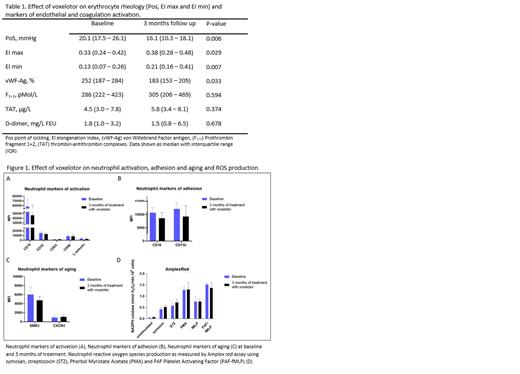Introduction
Sickle cell disease (SCD) is characterized by chronic intravascular hemolysis, caused by polymerization of abnormal sickle hemoglobin. The ongoing intravascular hemolysis leads to release of cell-free heme and iron, resulting in widespread oxidative damage, inflammation, neutrophil activation, endothelial activation and hypercoagulability, all contributing to vaso-occlusive events and end organ damage. Voxelotor, a small molecule reversibly binding to hemoglobin S (HbS) increases its oxygen affinity, thereby decreasing HbS polymerization and sickling, resulting in decreased hemolysis. The decrease in erythrocyte sickling might lead to improved erythrocyte deformability and decreased adhesion, while reductions in cell-free heme and labile plasma iron levels might result in decreased neutrophil activation, adhesion and aging and decreased endothelial activation.
The aim of this study is to assess the effects of voxelotor on erythrocyte deformability, neutrophil activation, adhesion and aging and endothelial activation.
Methods
SCD patients (HbSS and HbSβ 0-thalassemia), with hemoglobin (Hb) ≤ 10.5 g/dL were treated with voxelotor 1500 mg in a single arm interventional study. Blood was collected at baseline and after 3 months of treatment. Erythrocyte deformability was assessed by ektacytometry (Lorrca, RR mechatronics), measuring elongation index (EI) and point of sickling (PoS). EI max and EI min indicate the highest and lowest erythrocyte deformability upon oxygenation and deoxygenation respectively. PoS is the oxygen tension at which 5% reduction of the EI max is observed. Antigen expression of neutrophil markers for activation, adhesion and aging were assessed with flow cytometry. Reactive oxygen species (ROS) production of neutrophils was measured by Amplex Red Assay (Molecular probes), measuring hydrogen peroxide (H 2O 2) production under unstimulated and stimulated (zymosan, streptozotocin (STZ), factor-n-formyl-MET-LEU-Phe (fMLP), Phorbol myristate acetate (PMA)) and platelet-activating factor-fMLP (PAF-fMLP)). Endothelial activation was assessed by measuring von Willebrand Factor antigen (vWF-Ag) using enzyme-linked immunosorbent assay (ELISA) (Glostrup). Prothrombin fragment 1+2 (F 1+2), thrombin-antithrombin complexes (TAT) and D-dimer were measured using ELISA. Data are presented as median with interquartile range (IQR), unless stated otherwise. A P value of <0.05 was considered significant.
Results
15 SCD patients (11 HbSS, 4 HbSβ 0-thalassemia), 5 female, median age 35 years (IQR 27-46)) completed 3-month follow-up. Hb levels increased significantly after 3 months of treatment (from 7.4 (6.9 - 8.1) g/dL to 9.7 (7.9 - 11.0) g/dL, p=0.002), corresponding to significant decreases in LDH and bilirubin levels and reticulocyte counts as markers of hemolysis (p<0.05). PoS decreased significantly after 3 months (from 20.1 (17.5 - 26.1) mmHg to 16.1 (10.3 - 18.1) mmHg, p=0.006). Both EI max and EI min increased after 3 months of treatment (from 0.33 (0.24 - 0.42) to 0.38 (0.28 - 0.48), p=0.029 and from 0.13 (0.07 - 0.26) to 0.21 (0.16 - 0.41), p=0.007 respectively). Markers of neutrophil activation, adhesion and aging were generally lower after 3 months of treatment, though the differences were not statistically significant (Figure 1 A-C). Neutrophil ROS production in both unstimulated and stimulated condition remained unchanged (Figure 1D). After 3 months of treatment vWF-Ag significantly decreased (from 252 (187 - 284) % to 183 (153-205) %, p = 0.033). No changes were observed in markers of coagulation activation (F 1+2 and TAT, and D-dimer).
Conclusion
Voxelotor significantly improved erythrocyte deformability as suggested by decreased PoS and increased EI max and EI min, potentially leading to improved rheological properties. While markers of neutrophil activation seem to decrease, the differences are not statistically significant, possibly due to the relatively small sample size. A reduction in vWF-Ag was observed possibly reflecting diminished endothelial activation, due to a decrease in intravascular hemolysis.
Disclosures
Biemond:BMS: Research Funding; Global Blood Therapeutics/Pfizer: Other: Advisory board, Research Funding; Sanquin: Research Funding; Novo Nordisk: Other: Advisory board; Novartis: Other: Advisory board, Research Funding; Celgene: Other: Advisory board; CSL Behring: Other: Advisory board. Nur:Amgen: Consultancy, Speakers Bureau; VERTEX: Consultancy, Speakers Bureau; Novartis: Consultancy, Research Funding, Speakers Bureau.


